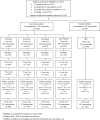Small-quantity lipid-based nutrient supplements, regardless of their zinc content, increase growth and reduce the prevalence of stunting and wasting in young burkinabe children: a cluster-randomized trial
- PMID: 25816354
- PMCID: PMC4376671
- DOI: 10.1371/journal.pone.0122242
Small-quantity lipid-based nutrient supplements, regardless of their zinc content, increase growth and reduce the prevalence of stunting and wasting in young burkinabe children: a cluster-randomized trial
Abstract
Small-quantity lipid-based nutrient supplements (SQ-LNS) are promising home fortification products, but the optimal zinc level needed to improve growth and reduce morbidity is uncertain. We aimed to assess the impact of providing SQ-LNS with varied amounts of zinc, along with illness treatment, on zinc-related outcomes compared with standard care. In a placebo-controlled, cluster-randomized trial, 34 communities were stratified to intervention (IC) or non-intervention cohorts (NIC). 2435 eligible IC children were randomly assigned to one of four groups:1) SQ-LNS without zinc, placebo tablet; 2) SQ-LNS containing 5mg zinc, placebo tablet; 3) SQ-LNS containing 10mg zinc, placebo tablet; or 4) SQ-LNS without zinc and 5mg zinc tablet from 9–18 months of age. During weekly morbidity surveillance, oral rehydration salts were provided for reported diarrhea and antimalarial therapy for confirmed malaria. Children in NIC (n = 785) did not receive SQ-LNS, tablets, illness surveillance or treatment. At 9 and 18 months, length, weight and hemoglobin were measured in all children. Reported adherence was 97 ± 6% for SQ-LNS and tablets. Mean baseline hemoglobin was 89 ± 15g/L. At 18 months, change in hemoglobin was greater in IC than NIC (+8 vs -1g/L, p<0.0001), but 79.1% of IC were still anemic (vs. 91.1% in NIC). Final plasma zinc concentration did not differ by group. During the 9-month observation period, the incidence of diarrhea was 1.10 ± 1.03 and of malaria 0.54 ± 0.50 episodes per 100 child-days, and did not differ by group. Length at 18 months was significantly greater in IC compared to NIC (77.7 ± 3.0 vs. 76.9 ± 3.4 cm; p<0.001) and stunting prevalence was significantly lower in IC (29.3%) than NIC (39.3%; p<0.0001), but did not differ by intervention group within IC. Wasting prevalence was also significantly lower in IC (8.7%) than in NIC (13.5%; p = 0.0003). Providing SQ-LNS daily with or without zinc, along with malaria and diarrhea treatment, significantly increased growth and reduced stunting, wasting and anemia prevalence in young children.
Trial registration: ClinicalTrials.gov NCT00944281.
Conflict of interest statement
Figures
References
-
- Murray CJ, Ortblad KF, Guinovart C, Lim SS, Wolock TM, Roberts DA, et al. Global, regional, and national incidence and mortality for HIV, tuberculosis, and malaria during 1990–2013: a systematic analysis for the Global Burden of Disease Study 2013. Lancet. 2014;384: 1005–1070. 10.1016/S0140-6736(14)60844-8 - DOI - PMC - PubMed
Publication types
MeSH terms
Substances
Associated data
LinkOut - more resources
Full Text Sources
Other Literature Sources
Medical



